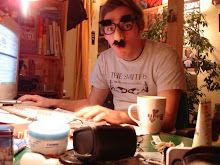Here are some rather touristic impressions from the field campaign (click on the pcitures to enlarge). The task of the first session was to find appropriate sections...
 The Peitlerkofel (Sas de Pütia) as seen from "Würzjoch". As you see there is still plenty of snow in May. We were'nt able to document a section here. The reddish/grey slope in the foreground is Grödner Sandstein Formation (Permian). Terrestrial plain and river sediments. The Permian Bellerophon Formation and the Permotriassic Werfen Formation is well-covered with snow.
The Peitlerkofel (Sas de Pütia) as seen from "Würzjoch". As you see there is still plenty of snow in May. We were'nt able to document a section here. The reddish/grey slope in the foreground is Grödner Sandstein Formation (Permian). Terrestrial plain and river sediments. The Permian Bellerophon Formation and the Permotriassic Werfen Formation is well-covered with snow. The Permian Grödner Sandstein of the Bletterbachschlucht. Supervisor for scale in the lower left. This is a spectacular gorge. Unfortunately the upper part of the canyon was not accessible due to floods earlier this year. So we did'nt see the P/T boundary below the Weisshorn.
The Permian Grödner Sandstein of the Bletterbachschlucht. Supervisor for scale in the lower left. This is a spectacular gorge. Unfortunately the upper part of the canyon was not accessible due to floods earlier this year. So we did'nt see the P/T boundary below the Weisshorn. The Werfen Formation below Cimon della Pala at Passo di Rolle. In fact a nice outcrop but very risky when it comes to sampling and documenting the section.
The Werfen Formation below Cimon della Pala at Passo di Rolle. In fact a nice outcrop but very risky when it comes to sampling and documenting the section. The Bellerophon Formation at the slopes of the Aferer Geisler seen from the Günther Messner Steig.
The Bellerophon Formation at the slopes of the Aferer Geisler seen from the Günther Messner Steig. The upper 30 metres or so of the Aferer Geisler section (Seis Member). Supervisor (black something) for scale somewhere in the lower left.
The upper 30 metres or so of the Aferer Geisler section (Seis Member). Supervisor (black something) for scale somewhere in the lower left. The lower Werfen (from lower right to upper left): Mazzin Member, Andraz Horizon Member, Seis Member, ?Gastropod Oolith Member and Campil Member (red). The photo is taken from the slopes between Cima dell Oumo and Costabella (Passo San Pellegrino).
The lower Werfen (from lower right to upper left): Mazzin Member, Andraz Horizon Member, Seis Member, ?Gastropod Oolith Member and Campil Member (red). The photo is taken from the slopes between Cima dell Oumo and Costabella (Passo San Pellegrino). The upper Werfen below Costabella. It does'nt look spectacular but it is the best outcrop seen so far to see the complete upper Werfen Formation without breaking my neck. It is just too far to identify the members from this perspective.
The upper Werfen below Costabella. It does'nt look spectacular but it is the best outcrop seen so far to see the complete upper Werfen Formation without breaking my neck. It is just too far to identify the members from this perspective. There it is: The End-Permian Extinction level at Rosengarten/Catinaccio. The lower bed is full of shelly fossils whilst the upper bed is devoid of life. Certainly, you can see such contrasts in other settings as well merely due to facies change or something but the following beds yield almost no fossils. Some authors refer to the "End Permian Death Zone".
There it is: The End-Permian Extinction level at Rosengarten/Catinaccio. The lower bed is full of shelly fossils whilst the upper bed is devoid of life. Certainly, you can see such contrasts in other settings as well merely due to facies change or something but the following beds yield almost no fossils. Some authors refer to the "End Permian Death Zone". A typical Dolomite landscape in Val Badia near Misci and Seres. The mountain in the background should be Kreuzkofel (Sasso Croce).
A typical Dolomite landscape in Val Badia near Misci and Seres. The mountain in the background should be Kreuzkofel (Sasso Croce).













3 comments:
gorgeous photos! I especially like the 'Bob Ross' one :)
Excellent pictures! Would you mind if I borrowed the "Permian death zone" photo (link and attribution, of course)? I just showed that to a couple of students here (not geo people), and after I explained what they were seeing, it was a real kick to watch the amazement in their eyes.
Thank you!
No problem. Feel free to use it.
Post a Comment